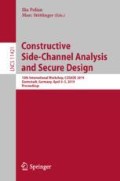Abstract
Threshold Implementations are well known as a provably first-order secure Boolean masking scheme even in the presence of glitches. A precondition for their security proof is a uniform input distribution at each round function, which may require an injection of fresh randomness or an increase in the number of shares. However, it is unclear whether violating the uniformity assumption causes detectable leakage in practice. Recently, Daemen undertook a theoretical study of lossy mappings to extend the understanding of uniformity violations. We complement his work by entropy simulations and practical measurements of Keccak’s round function. Our findings shed light on the necessity of mixing operations in addition to bit-permutations in a cipher’s linear layer to propagate randomness between S-boxes and prevent exploitable leakage. Finally, we argue that this result cannot be obtained by current simulation methods, further stressing the continued need for practical leakage measurements.
Access this chapter
Tax calculation will be finalised at checkout
Purchases are for personal use only
Notes
- 1.
Later extended to higher-order security.
- 2.
Standardized for selected parameters as SHA-3 in 2015.
- 3.
The addition of round constants would further increase the total imbalance in the \(\chi '\)-only scenario, but it is of no interest for the investigation of full Keccak.
- 4.
As it is already computationally infeasible for Keccak-25, we kept the consistency between measurements and simulations by evaluating Keccak-200.
- 5.
The groups fixed vs. random are formed over the entire 200-bit state.
- 6.
The peak coincides with the positive edge during the evaluation of \(\chi '\).
References
Side-channel AttacK User Reference Architecture. http://satoh.cs.uec.ac.jp/SAKURA/index.html
Arribas, V., Nikova, S., Rijmen, V.: VerMI: verification tool for masked implementations. IACR Cryptology ePrint Archive, 2017:1227 (2017)
Barthe, G., Belaïd, S., Fouque, P.-A., Grégoire, B.: maskVerif: a formal tool for analyzing software and hardware masked implementations. IACR Cryptology ePrint Archive, 2018:562 (2018)
Bertoni, G., Daemen, J., Peeters, M., Van Assche, G.: Keccak. In: Johansson, T., Nguyen, P.Q. (eds.) EUROCRYPT 2013. LNCS, vol. 7881, pp. 313–314. Springer, Heidelberg (2013). https://doi.org/10.1007/978-3-642-38348-9_19
Beyne, T., Bilgin, B.: Uniform first-order threshold implementations. In: Avanzi, R., Heys, H. (eds.) SAC 2016. LNCS, vol. 10532, pp. 79–98. Springer, Cham (2017). https://doi.org/10.1007/978-3-319-69453-5_5
Bilgin, B., Daemen, J., Nikov, V., Nikova, S., Rijmen, V., Van Assche, G.: Efficient and first-order DPA resistant implementations of Keccak. In: Francillon, A., Rohatgi, P. (eds.) CARDIS 2013. LNCS, vol. 8419, pp. 187–199. Springer, Cham (2014). https://doi.org/10.1007/978-3-319-08302-5_13
Bloem, R., Gross, H., Iusupov, R., Könighofer, B., Mangard, S., Winter, J.: Formal verification of masked hardware implementations in the presence of glitches. In: Nielsen, J.B., Rijmen, V. (eds.) EUROCRYPT 2018. LNCS, vol. 10821, pp. 321–353. Springer, Cham (2018). https://doi.org/10.1007/978-3-319-78375-8_11
Bogdanov, A., et al.: PRESENT: an ultra-lightweight block cipher. In: Paillier, P., Verbauwhede, I. (eds.) CHES 2007. LNCS, vol. 4727, pp. 450–466. Springer, Heidelberg (2007). https://doi.org/10.1007/978-3-540-74735-2_31
Daemen, J.: On non-uniformity in threshold sharings. In: Bilgin, B., Nikova, S., Rijmen, V. (eds.) Proceedings of the ACM Workshop on Theory of Implementation Security, TIS@CCS 2016, p. 41. ACM, New York (2016)
Daemen, J.: Spectral characterization of iterating lossy mappings. In: Carlet, C., Hasan, M.A., Saraswat, V. (eds.) SPACE 2016. LNCS, vol. 10076, pp. 159–178. Springer, Cham (2016). https://doi.org/10.1007/978-3-319-49445-6_9
Daemen, J.: Changing of the guards: a simple and efficient method for achieving uniformity in threshold sharing. In: Fischer, W., Homma, N. (eds.) CHES 2017. LNCS, vol. 10529, pp. 137–153. Springer, Cham (2017). https://doi.org/10.1007/978-3-319-66787-4_7
Ishai, Y., Sahai, A., Wagner, D.: Private circuits: securing hardware against probing attacks. In: Boneh, D. (ed.) CRYPTO 2003. LNCS, vol. 2729, pp. 463–481. Springer, Heidelberg (2003). https://doi.org/10.1007/978-3-540-45146-4_27
Jungk, B., Apfelbeck, J.: Area-efficient FPGA implementations of the SHA-3 finalists. In: Athanas, P.M., Becker, J., Cumplido, R. (eds.) 2011 International Conference on Reconfigurable Computing and FPGAs, ReConFig 2011, pp. 235–241. IEEE Computer Society, Washington, D.C. (2011)
Kocher, P., Jaffe, J., Jun, B.: Differential power analysis. In: Wiener, M. (ed.) CRYPTO 1999. LNCS, vol. 1666, pp. 388–397. Springer, Heidelberg (1999). https://doi.org/10.1007/3-540-48405-1_25
De Meyer, L., Bilgin, B., Reparaz, O.: Consolidating security notions in hardware masking. IACR Cryptology ePrint Archive, 2018:597 (2018)
Moradi, A., Richter, B., Schneider, T., Standaert, F.-X.: Leakage detection with the x2-test. IACR Trans. Cryptogr. Hardw. Embed. Syst. 2018(1), 209–237 (2018)
Nikova, S., Rechberger, C., Rijmen, V.: Threshold implementations against side-channel attacks and glitches. In: Ning, P., Qing, S., Li, N. (eds.) ICICS 2006. LNCS, vol. 4307, pp. 529–545. Springer, Heidelberg (2006). https://doi.org/10.1007/11935308_38
National Institute of Standards and Technology: Sha-3 standard: permutation-based hash and extendable-output functions. FIPS Publikcation 2015:1–37 (2015)
Poschmann, A., Moradi, A., Khoo, K., Lim, C.-W., Wang, H., Ling, S.: Side-channel resistant crypto for less than 2, 300 GE. J. Cryptology 24(2), 322–345 (2011)
Reparaz, O., Bilgin, B., Nikova, S., Gierlichs, B., Verbauwhede, I.: Consolidating masking schemes. In: Gennaro, R., Robshaw, M. (eds.) CRYPTO 2015. LNCS, vol. 9215, pp. 764–783. Springer, Heidelberg (2015). https://doi.org/10.1007/978-3-662-47989-6_37
Schneider, T., Moradi, A.: Leakage assessment methodology. In: Güneysu, T., Handschuh, H. (eds.) CHES 2015. LNCS, vol. 9293, pp. 495–513. Springer, Heidelberg (2015). https://doi.org/10.1007/978-3-662-48324-4_25
Wegener, F., Moradi, A.: A first-order SCA resistant AES without fresh randomness. In: Fan, J., Gierlichs, B. (eds.) COSADE 2018. LNCS, vol. 10815, pp. 245–262. Springer, Cham (2018). https://doi.org/10.1007/978-3-319-89641-0_14
Acknowledgments
The work described in this paper has been supported in part by the German Federal Ministry of Education and Research BMBF (grant nr. 16KIS0666 SysKit_HW).
Author information
Authors and Affiliations
Corresponding author
Editor information
Editors and Affiliations
Rights and permissions
Copyright information
© 2019 Springer Nature Switzerland AG
About this paper
Cite this paper
Wegener, F., Baiker, C., Moradi, A. (2019). Shuffle and Mix: On the Diffusion of Randomness in Threshold Implementations of Keccak. In: Polian, I., Stöttinger, M. (eds) Constructive Side-Channel Analysis and Secure Design. COSADE 2019. Lecture Notes in Computer Science(), vol 11421. Springer, Cham. https://doi.org/10.1007/978-3-030-16350-1_15
Download citation
DOI: https://doi.org/10.1007/978-3-030-16350-1_15
Published:
Publisher Name: Springer, Cham
Print ISBN: 978-3-030-16349-5
Online ISBN: 978-3-030-16350-1
eBook Packages: Computer ScienceComputer Science (R0)

